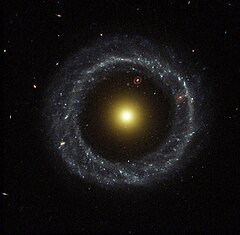Obiekt Hoaga
 Obiekt Hoaga (HST) | |
| Odkrywca | |
|---|---|
| Data odkrycia | 1950 |
| Dane obserwacyjne (J2000) | |
| Gwiazdozbiór | |
| Typ | |
| Rektascensja | 15h 17m 14,4s |
| Deklinacja | +21° 35′ 07,8″ |
| Odległość | 600 mln ly |
| Przesunięcie ku czerwieni | 0,0424 |
| Jasność obserwowana | 15,1m |
| Rozmiary kątowe | 0,28' × 0,28' |
| Charakterystyka fizyczna | |
| Wymiary | 120 000 ly |
| Alternatywne oznaczenia | |
| 2MASS J15171440+2135078, PGC 54559, PRC D-51 | |
Obiekt Hoaga – galaktyka pierścieniowa znajdująca się w głowie konstelacji Węża na granicy z Wolarzem. Została odkryta w 1950 roku przez Arthura Hoaga. Galaktyka ta jest odległa o około 600 milionów lat świetlnych od Ziemi, a jej średnica ma około 121 tys. lat świetlnych.
Obiekt Hoaga jest jedną z najbardziej wyjątkowych galaktyk. Na zewnątrz galaktyki znajduje się wyraźnie oddzielony pierścień, rozciągający się od 75 do 121 tysięcy lat świetlnych od centrum, zdominowany przez jasne, niebieskie gwiazdy. W centrum obiektu znajduje się okrągłe, świecące na żółto (dzięki starym gwiazdom) jądro o rozmiarach 17 tysięcy lat świetlnych.[1] Pomiędzy tymi elementami znajduje się przerwa, która wydaje się być całkowicie przezroczysta. W przerwie tej widoczna jest inna galaktyka pierścieniowa znajdująca się w górę od centrum, daleko za obiektem. Nie oznacza to jednak, że przerwa ta jest pusta, może ona zawierać dużą liczbę słabych gwiazd.
Pierścieniowa struktura Obiektu Hoaga sugeruje jego podobieństwo do Galaktyki Koło Wozu, jednak w pobliżu nie znajdują się żadne galaktyki, które mogłyby być odpowiedzialne za kolizję. Przyczyna powstania Obiektu Hoaga i innych odkrytych już podobnych obiektów nie jest znana. Według jednej z dwóch teorii galaktyki tego typu mogą należeć do nietypowej klasy galaktyk spiralnych, w których dwa ramiona spiralne przekształciły się w okrąg. Według drugiej teorii galaktyka tego typu byłaby dawną galaktyką eliptyczną, która wchłonęła inną galaktykę i wytworzyła pierścień materii gwiazdotwórczej.
Przypisy
- ↑ Kamil Złoczewski: Kosmos. Wąż. T. 78. Poznań: Amermedia Sp. z o.o., 2013, s. 232. ISBN 978-83-252-2118-8.
Bibliografia
- Encyklopedia Wszechświat. Praca zbiorowa. Warszawa: Wydawnictwo Naukowe PWN, 2006, s. 309. ISBN 978-83-01-14848-5.
- Obiekt Hoaga w bazie SIMBAD (ang.)
Linki zewnętrzne
Media użyte na tej stronie
A nearly perfect ring of hot, blue stars pinwheels about the yellow nucleus of an unusual ring galaxy known as Hoag's Object. This image from NASA's Hubble Space Telescope captures a face-on view of the galaxy's ring of stars, revealing more detail than any existing photo of this object. The image may help astronomers unravel clues on how such strange objects form.
The entire galaxy is about 120,000 light-years wide, which is slightly larger than our Milky Way Galaxy. The blue ring, which is dominated by clusters of young, massive stars, contrasts sharply with the yellow nucleus of mostly older stars. What appears to be a "gap" separating the two stellar populations may actually contain some star clusters that are almost too faint to see. Curiously, an object that bears an uncanny resemblance to Hoag's Object can be seen in the gap at the one o'clock position. The object is probably a background ring galaxy.
Ring-shaped galaxies can form in several different ways. One possible scenario is through a collision with another galaxy. Sometimes the second galaxy speeds through the first, leaving a "splash" of star formation. But in Hoag's Object there is no sign of the second galaxy, which leads to the suspicion that the blue ring of stars may be the shredded remains of a galaxy that passed nearby. Some astronomers estimate that the encounter occurred about 2 to 3 billion years ago.
This unusual galaxy was discovered in 1950 by astronomer Art Hoag. Hoag thought the smoke-ring-like object resembled a planetary nebula, the glowing remains of a Sun-like star. But he quickly discounted that possibility, suggesting that the mysterious object was most likely a galaxy. Observations in the 1970s confirmed this prediction, though many of the details of Hoag's galaxy remain a mystery.
The galaxy is 600 million light-years away in the constellation Serpens. The Wide Field and Planetary Camera 2 took this image on July 9, 2001.